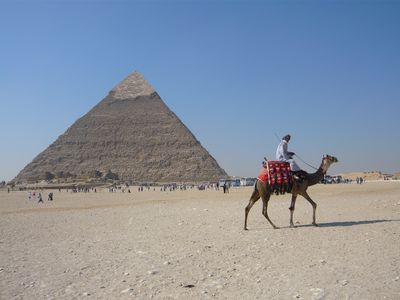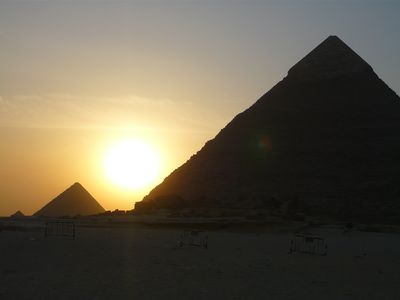Out Of Egypt
Premieres: Southeast Asia on Nov 24 at 9:00 pm; Australasia on Nov 27 at 9:30 pm; North Asia on Oct 5 at 9:00 pm; Japan on Oct 7 at 9:00 pm
DISCOVERY CHANNEL'S OUT OF EGYPT SPANS THE GLOBE UNRAVELING COMMON THREADS OF ANCIENT CIVILIZATIONS
Secret societies, ritual sacrifice, brutal religious edicts, macabre burials - how are ancient civilizations linked together and what does it say about human instinct? A whole new kind of class is in session with the dynamic, engaging Dr Kara Cooney. Join this UCLA Professor of Egyptian Art and Architecture as she trades the lecture hall for tombs and temples around the world bringing, an exciting new perspective to the most fascinating riddles in history in OUT OF EGYPT.
Kara uses her understanding of Egyptian customs and practices as a baseline to study how other ancient societies were formed. In Pyramids, she takes a closer look at these iconic monuments. In 2560 BC, the ancient Egyptians built the Giza Pyramid. Nearly 2,700 years later and some 7,700 miles away, the Aztecs erected a similarly imposing structure. A coincidence? Kara explains that human nature's desire to be close to the gods, to literally build a conduit to greater holiness, can be seen in civilizations far from Egypt, from the construction of the stepped temples of Mexico to the round pyramids of Sri Lanka.
In Relics, Kara investigates how and why our hallowed dead are preserved and worshipped. A relic could be the finger of a Catholic saint or a mummified ibis bird buried in an ancient Egyptian catacomb. For millennia, people have ascribed meaning and power to these remnants of their hallowed dead but why? Kara explains that the bodies might be dead, but they remain buried in our current physical world. They are then seen as somehow magical - a bridge from the living here on Earth to the dead in the heavens beyond.
To illustrate these beliefs, Kara undergoes a ritual cleansing in Mexico involving human bones, takes part in a Buddhist burning ceremony in Vietnam and pays a special visit to Sri Lanka's most holy shrine - The Temple of the Tooth - to pay respects to what is believed to be the actual tooth of the Buddha. Throughout history, loved ones, martyrs and political figures all share the appearance of being closer to Gods just by the fact that they are no longer among the living.
Each episode begins in Egypt, where she asks a question that launches her on a quest around the world, As Kara interviews experts and visits sacred sites, she expertly crafts links between the social and religious practices of these ancient cultures. Kara also looks at beliefs that built and destroyed civilizations, traces the origins of the Devil and literally descends into the underworld of ancient burial practices. For episode descriptions, please see attached.
As Kara ventures OUT OF EGYPT over continents and countries to study the Mayans of Central America, the Incas of Peru, the Singhalese of Sri Lanka and other civilizations, she discovers that when faced with the same materials on Earth, the same biological matter and laws of physics, people will come up with very similar strategies independently of one other.
OUT OF EGYPT episode descriptions:
Sins of the City
Today's city dwellers may think of urban living as an improvement over the existence of our hunting and gathering ancestors. But Egyptologist Kara explains that our modern tendency to live in cities isn't the result of an inevitable march towards progress. Beginning roughly 12,000 years ago, a sudden change in human behaviour determined the very nature of modern civilization. And archaeological evidence from some of the world's first cities - like Jericho in the West Bank of Palestine, Catal Huyuk in Turkey, and even early prehistoric settlements in Egypt - suggests that living in cities may bring just as many problems as it solves.
The Shape of the Gods
The great pyramids at Giza - awe inspiring icons of Ancient Egypt. But these monuments are not unique. Thousands of pyramids have been built all across the globe. Dr Kara Cooney travels from the very first pyramids in Egypt to the temples of Mexico, and even to round pyramids in Sri Lanka, demonstrating that the history of these buildings hides a long and twisted evolution of architecture and form. Ancient pyramid builders everywhere attempted to master an ideal sacred shape, but what did the pyramid really mean to the ancient people? And why did they work so hard to perfect it?
The Birth of the Devil
The Ancient Egyptians practiced a complex religion of many gods, and yet they had no devil in their mythology. In fact, most ancient cultures had no conception of the devil. It's only with later, monotheistic beliefs that the notion of pure evil emerges, along with its embodiment, the devil. By examining a historic period of dramatic transition in religious beliefs, Kara pinpoints a moment that brought profound change to cultures all around the Mediterranean - a shift in politics and society that molded the very nature of divinity and beliefs still followed by many today.
Disposal of the Dead
For ancient Egyptians, the dead body was a precious thing meant to be preserved. Egyptian mummies, as well as mummies from cultures as diverse as the Moche of Peru or the first city dwellers of the Middle East, all represent an intense and expensive preparation of the dead. Kara examines tombs, graves, and burials all over the world, explaining that many cultures' methods of treating the dead embody a coping mechanism for dealing with death itself, one unavoidable element that links people around the world and throughout history.
Sacred Violence
At the front of nearly every ancient Egyptian temple stands a stone wall, decorated with a massive depiction of the king crushing his enemies with a stone mace. This brutal imagery played a central role in the ancient Egyptian religion, believed to magically protect the temple from the forces of chaos. But Kara explains that this isn't unique. Be it human sacrifice at an Aztec pyramid, burning witches in Salem or the torture chambers of the Spanish Inquisition, she demonstrates that acts of violence have continued to be a fundamental part of religious belief for millennia.
Flesh and Bone
The bodies of our hallowed dead - preserved and worshiped for generations. These objects are often called 'relics,' and their existence represents a near universal behaviour in human culture. A relic could be the finger of a Catholic saint or a mummified ibis bird buried in an ancient Egyptian catacomb. For millennia, people have ascribed meaning and power to the remnants of their hallowed dead. Kara visits sites of pilgrimage, both ancient and modern to explain the reasons and motives behind the value we place on treasured Flesh and Bone.
Some of the media you are attempting to download are from Networks that limit downloads to 5 per day.




